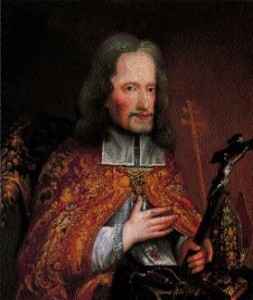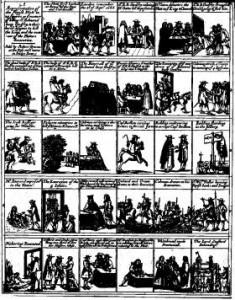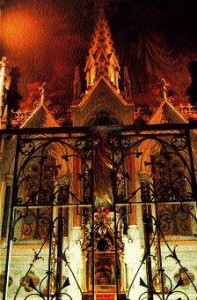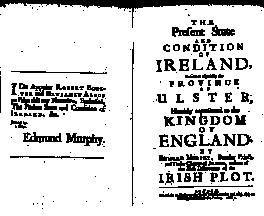Edmund Murphy, Oliver Plunkett and the Popish Plot
Published in Early Modern History (1500–1700), Features, Issue 4 (Winter 2004), Volume 12
Oliver Plunkett (1681) by Garret Morphy. (National Portrait Gallery, London)
Oliver Plunkett is unquestionably one of the best-known churchmen in Irish history. Of Old English stock from Meath, he left Ireland during the chaos of the 1640s to be educated in Rome, eventually returning to Ireland as archbishop of Armagh. An energetic and gifted (if contentious) reformer, he was arrested in December 1679 and executed in London in July 1681. He had been falsely implicated in the Popish Plot, the outburst of anti-Catholic hysteria in England prompted by the claims of Titus Oates in September 1678 of a Catholic conspiracy in England intended to wipe out Protestantism there. Plunkett died a traitor’s death, being hung, drawn and quartered at Tyburn, but would eventually become Ireland’s most famous Catholic martyr. Beatified and canonised in the twentieth century, today his fame is partly due to the grim fact that his severed head remains on display in St Peter’s Cathedral in Drogheda.
Atmosphere of intense anti-Catholicism
But at least he is known. Edmund Murphy remains obscure. His fleeting notoriety stems from his role as both informer and witness in the sequence of events that led to Plunkett’s trial and execution in July 1681. Born in Armagh, he was the parish priest of Killeavy in the same county, and in 1674 was suspended from his duties by Plunkett for drunken behaviour and dealings with the bandits known as Tories. His clerical career was chequered; when Plunkett was later questioned before his trial in London as to whether he knew Murphy, he replied that ‘he did know him too well’. But from early 1680 Edmund Murphy became intimately involved in the furious attempts by figures in England such as Anthony Ashley Cooper, earl of Shaftesbury, to promote allegations that a Catholic rebellion in Ireland was imminent. By this time the Popish Plot had given way to the Exclusion Crisis, the intense political struggle that arose in England between 1679 and 1681 over the vexing question of who would succeed Charles II as king. As matters stood in 1679 the heir was a Catholic, Charles’s younger brother James, duke of York, who had already been tainted by Oates’s allegations. In an atmosphere of intense anti-Catholicism this was bound to be an issue, and Shaftesbury would, over the next two years, spearhead a campaign to exclude York from the succession. Scare-mongering about Ireland was meant to amplify anti-Catholic paranoia in England, and so boost the campaign to bar York from the throne. The Catholic Irish were supposedly ready to rise, with the intention of massacring Ireland’s Protestants. The French would then land there, and the combined Franco-Irish force would attack England to embark upon a similar massacre of English Protestants. To add credence to these claims, obscure and dubious figures would be persuaded to come from Ireland and testify to this before the English parliament.

A Representation of the Popish Plot in 29 figures. . . (Harvard University Library)
Murphy was one of them. Imprisoned in Dundalk c. 1679, he met William Hetherington, and joined him in claiming knowledge of an imminent Irish rebellion, with French assistance, in which they both implicated Plunkett. Seemingly they escaped; Hetherington went to London, where he was patronised by Shaftesbury, and Murphy eventually followed. But when Murphy was examined in London before the English Privy Council in May 1680 he claimed to be unaware of any plot currently in progress. He was sent back to Ireland, but the viceroy, James Butler, duke of Ormond, was subsequently instructed to prosecute Plunkett and a number of others. Murphy was recommended to Henry Jones, bishop of Meath, who sought a pardon for him, and he subsequently accompanied Hetherington to Ulster to obtain more evidence. However, when Plunkett’s first trial opened in Dundalk in July 1680 Murphy refused to testify and absconded to England. He was apparently afraid of arrest or retribution; and as other witnesses also refused to testify, Plunkett’s trial collapsed.
But in October 1680 Edmund Murphy was granted authority to procure more witnesses in Ireland. In November 1680 he testified before the English House of Lords, and in January 1681 he assented to the publication of The present state and condition of Ireland, but more especially the province of Ulster. On the face of it, this was only one of a number of Irish testimonies published as pamphlets at this time, offering accounts of Catholic plotting in Ireland that was supposedly a prelude to rebellion. But Murphy’s was unusual because it did not actually do this. What it provided instead was a detailed and intricate account of his activities in Armagh that opened a window into obscure events in Ireland that supposedly raised the possibility of war once again across the Stuart kingdoms.
Armagh and Toryism
County Armagh acted as a border zone between Leinster and Ulster, and the county had been heavily settled under the Ulster Plantation; by 1641 native Irish landowners retained perhaps 24 per cent of land in the county. The remainder was split between the Church of Ireland, Trinity College Dublin, and a variety of Old English families and newer British settlers. The remnant retained in Irish hands was mainly in the baronies of Orier and the Fews in south Armagh. Yet while the native landowning classes had been supplanted, they remained in situ, and by the second half of the seventeenth century Armagh remained unstable. Economically stagnant, with a low population, often impassable geography and a fragmented society, it retained an uneasy balance between natives and newcomers, and was subject to neither’s law. Such a situation was bound to breed lawlessness; it bred and facilitated Tories.
The Tory was probably inevitable in seventeenth-century Ireland, and particularly in Armagh. For there, as in other parts of the island, they were more than merely criminals. Drawn largely from amongst the dispossessed (with an anti-settler and anti-Protestant perspective on that account), they were the main internal security problem in Ireland during the Restoration period. Murphy’s pamphlet was mostly concerned with Tory activity in Armagh and Louth, and the collusion of English military personnel with Tories. In particular, it focused on the notorious Armagh Tory Redmond O’Hanlon and claims of his direct dealings with Plunkett. It provided a remarkable account of events in Armagh in the late 1670s. It was inevitably shaped by Murphy’s self-interest (material incriminating him was excluded), but in recounting the events he had been involved in, whether as priest, criminal or ostensibly concerned subject, he offered a rare testimony in English that connected the exalted realms of international plotting with the reality of life on the ground in the Armagh of the late 1670s. Murphy’s was the worm’s-eye view. And he began with Redmond O’Hanlon.
Murphy’s tale

Plunkett’s preserved head as displayed on the altar of St Peter’s Cathedral, Drogheda. (Homer Sykes)
Originally from Poyntzpass, O’Hanlon came to prominence as a dangerous and elusive Tory leader in Armagh and Louth in the 1670s. Murphy claimed to be concerned that his parish suffered from the depredations of O’Hanlon and his gang, and so he had preached against them. In response, O’Hanlon threatened to levy fines of, respectively, one cow, two cows and death upon anyone attending Murphy’s sermons. Murphy himself fled the parish after O’Hanlon murdered a parishioner, and hired a curate to preach in his place. At this point, Cormucke Raver O’Murphy emerged. A thief and former herdsman to one Lt Henry Baker, he had joined O’Hanlon’s gang and was active in September 1678, when Murphy, given his parishioners’ fears, sought out Baker to deal with O’Hanlon. The latter proved reluctant to do this, and the reasons soon became clear. Murphy became suspicious when it emerged that Baker was godfather to a proclaimed Tory’s child. Final proof of collusion came when Murphy’s brother Phelemy encountered Baker and Cormucke Raver drinking together and wrestling in a quarry.
Eventually, however, Cormucke Raver split from O’Hanlon, and a feud arose between the two. Consequently, one Captain William Butler sought Murphy’s assistance in dealing with O’Hanlon, and both settled upon Cormucke Raver as the instrument. Cormucke remained wary, claiming that O’Hanlon had extensive contacts amongst both the army and the Catholic clergy, but eventually relented, and an elaborate scheme to ambush O’Hanlon was devised. But this was hampered in suspicious circumstances and Murphy, who was shuttling between the various parties, was accused of becoming a Tory-hunter. Being in imminent danger, he absconded to Dundalk. Further escapades ensued, until Cormucke Raver was shot by one of his own associates. Murphy continued his campaign against O’Hanlon, attempting to recruit Cormucke’s disgruntled family to his cause, but was eventually arrested for his troubles, being accused by another soldier, Ensign John Smith, of seeking to murder him (Smith was himself accused by Murphy of colluding with O’Hanlon). Eventually released from prison, Murphy involved himself again in the rapidly escalating intrigues aimed at capturing O’Hanlon and his band. By October 1679 events were moving towards some kind of resolution, but soon he was imprisoned again, supposedly on a trumped-up charge. He narrowly escaped execution, and learned that he had been excommunicated by Plunkett; his accusers were supposedly in league with Plunkett ‘to carry on the plot by means of the Tories’, having permitted ‘Plunkett’s provincial council for the destruction of all the Protestants’. This was Plunkett’s first appearance in an account that was specifically targeted at him.
As for Murphy, imprisoned without bail, he managed to give his account to Hetherington who, furnished with this testimony, sought to disclose the (admittedly vague) plot. And from here Murphy’s account, while recounting the further adventures of its protagonists, substantively petered out.
The background and its relevance
What did Murphy’s tale suggest? It provided a deeply partisan view of society in Armagh at this time but, unusually in English, it offered a view of Tory activity and its backdrop by one intimately involved in it. What he excluded was, of course, equally suggestive: his own criminal past, and the awkward local rumour that he himself had killed Cormucke Raver O’Murphy. The emphasis on the supposed existence of an Irish Catholic plot ignored the continual (and more real) fears of unrest among Scottish Presbyterians in Ulster that so preoccupied governments in Dublin. But the fact that this testimony became relevant at this juncture is suggestive of the fear of Catholics in general, and Irish Catholics in particular, that the Popish Plot tapped into. Murphy’s perspective can be interrogated and contrasted with the realities he sought to manipulate. While it has an intrinsic value as a detailed descriptive account, not to mention as a footnote to Plunkett’s career, its existence illustrates the intersection of Irish and British history at a moment of crisis, and its composition illustrates the forgotten reality that Ireland played a part in both the Popish Plot and the subsequent Exclusion Crisis.
Shaftsbury’s claims about the existence of an Irish plot had a number of distinct elements, of which the attempt to implicate Plunkett was one. Alongside Murphy’s testimony were other accounts based on the testimonies of other Irish informers. Taken as a whole they amounted to a body of evidence strongly suggesting that there was indeed a plot afoot in Ireland; the English House of Commons would pass a resolution to that effect in January 1681. Such claims played upon beliefs, but at the core of those beliefs was a very real fear of Catholicism and of Catholics. This was nothing new, but England lacked a tangible basis for this in specific examples of what Catholics might potentially do; events such as the St Bartholomew’s Day massacre in France sprang to mind, but there was nothing comparable in England. However, the rebellion of 1641 in Ireland could, and did, provide a model. Printed propaganda in the decades after the event had dwelt upon lurid stories of atrocities against Protestants in 1641, as propagated by polemicists such as Sir John Temple. But within this was the ever-present subtext that such things could happen again. For many in the late 1670s, in Ireland and in England, these events were within living memory. Equally, for many in England the events of the Exclusion Crisis bore a disturbing resemblance to the events that had led to the Civil War in the 1640s. And as English minds harked back to those events, it was probably inevitable that they would begin to dwell on the events in Ireland of 1641. In Ireland, the fear that Catholics would seek to wipe out the Protestant settlers whom they vastly outnumbered did not just draw credence from the notion that Catholics were duty-bound to wipe out heretics. It also drew strength from the tangible reality that the Catholic Irish might attempt to get back the lands they had so recently lost. This was the context into which Murphy’s claims would fit, and by the end of the 1670s he stood at the intersection of a number of outstanding issues.
Ireland and anti-Popery in the seventeenth century

The title page of Murphy’s pamphlet, which provided a detailed account of his activities in Armagh. (National Library of Ireland)
Why would the account of an informer about bandits in a relatively obscure part of Ireland be relevant to anyone at this time? To ask this is to ask why Ireland would be relevant. The enduring fear of a re-run of 1641 was obvious, and remained widespread in Ireland among those who had most to fear from it: Protestant settlers. Indeed, Armagh had been the scene of some of the most notorious and widely publicised events of that rebellion. And from an English perspective, Ireland could be seen not only as dangerous in itself but also as the final geographical link that caused England to be surrounded by Catholic power, most notably Catholic France. But Tories in Ireland were another factor in such fears, as they had relevance at this time far beyond banditry. The term was synonymous with dispossession and the Catholic Irish, and it was a phenomenon that had attracted the reforming zeal of Plunkett after his appointment to Armagh. His Meath background did not endear him to Armagh’s clerics (‘Armaghmen without exception are not suitable as preachers of the word of God’), but the travails of the dispossessed in his diocese who had become Tories caught both his attention and his sympathy. Acutely aware of their situation, of their depredations and of the retaliation against the Irish that inevitably followed their actions, he made himself available as an intermediary between the government in Dublin (particularly under Sir John Berkeley) and the Tories in exchange for a measure of de facto religious toleration. He subsequently persuaded a number of Tories to leave Ireland, and continued to do so; for Plunkett, Tories would remain a preoccupation.
But Tory activity could be construed as an integral part of any attempt to orchestrate a rebellion; witness testimonies and allegations about supposed Irish plots often directly linked them to Tories. Murphy’s testimony before the English House of Lords on 4 November 1680 differed from his pamphlet; he claimed then that Plunkett sought ‘to bring in the French to no other end but to murder all the Protestants in one week’, and had sought to recruit Tories to his cause, encouraging them to go to France to seek redress for their dispossession. Such claims had a resonance; after O’Hanlon’s death in April 1681, the word ‘Tory’ would embark on its long journey through English political history, starting as a term of abuse directed at supporters of the ostensibly pro-Catholic court.
The relevance and value of Murphy’s testimony was that it readily fitted into the mesh of uncertain events, beliefs and expectations about the Irish at this time. This was not necessarily his priority; he had almost certainly seen an opportunity to save himself as Irish witnesses were sought by the nascent Whig opposition in England. Amongst those whom Murphy had implicated were the two soldiers who had imprisoned him in 1679, which suggested an element of revenge that may also have been extended to Plunkett. However, by May 1681 Murphy had begun to show a willingness to retract, admitting that he and others had been encouraged to testify against figures such as Ormond. Yet despite the fact that the claims of Murphy and the other plot witnesses were collapsing, expectations and the demand for some form of reckoning in England would ensure that Plunkett’s onward march towards Tyburn gallows had by now developed an unstoppable momentum.
But Murphy proved an unhelpful witness at Plunkett’s trial in June 1681. Having previously sworn against him, Murphy declined to do so here, claiming to have forgotten his testimony. He did not directly implicate Plunkett in any plot, and claimed that the other witnesses against him, some of whom were connected to both Murphy and Plunkett, were motivated by malice; grudges arising from Plunkett’s tenure in Armagh undoubtedly motivated some of them. Plunkett may have appreciated Murphy’s gesture, and may have suppressed his own evidence against him in the light of what seemed to be repentance. Murphy was subsequently imprisoned, but was eventually sent back to Ireland, and little more remains. By this time Plunkett was executed, and the head of Murphy’s nemesis O’Hanlon had been mounted over Downpatrick Jail. In December 1681 another informer, Owen Murphy, stated that Edmund Murphy and others had agreed to testify against Ormond, York and the queen in January 1681. The informer Eustace Comyn later claimed that Murphy had been open to bribes to save Plunkett from execution. In August 1682 Murphy was reported to be working on a farm in Kent, and on 27 September 1682 he was discharged from the secret service payroll on which he had been maintained, and vanished from the record.
Conclusion
The connections between Ireland and the Popish Plot are generally overlooked by historians. But the plot drew strength and credence from the fear of Catholics prevalent across the Stuart kingdoms, not just England. Religion remained the key issue at stake for many in Ireland and England; in this way, the two countries intersected on the level of mentality. Without an awareness and fear of any prospective ‘Irish plot’, why were claims about such a plot promoted? The Popish Plot and Exclusion Crisis had an enormous impact upon Ireland, but this was a two-way street, for Ireland also had a role to play within the Popish Plot and the Exclusion Crisis as they crystallised in England. The spectres of 1641 and the supposedly murderous intentions of the Catholic Irish, as hinted at in the claims of figures such as Murphy, tapped into older and deeper fears in both islands. In Britain there were fears of Catholicism from without, and in Ireland from within. The question of who would be the masters of Ireland was by no means resolved by the 1670s, for at the back of many minds was a lurking fear that the nascent Protestant establishment might yet be undermined or overthrown. These fears were thrown into stark relief by Murphy and his ilk, and their claims had great significance at a time when all in Ireland might yet be up for grabs. In Ireland the Popish Plot impacted upon a deeply unsettled country, and Oliver Plunkett was its most famous Irish victim. But in its impact lies its relevance, as it had the potential to unsettle Ireland further, perhaps irretrievably, and figures such as Edmund Murphy can offer a path into the Plot as it straddled both Britain and Ireland. Against the background of his time and place, a hitherto obscure figure like Murphy can acquire a new importance. And in that light he, and others like him, might be worth the trouble of taking more seriously.
John Gibney is a PhD student in the Department of Modern History, Trinity College, Dublin.
Further reading:
S.J. Connolly, Religion, law and power: the making of Protestant Ireland, 1660–1760(Oxford, 1992).
A. Curtayne, The trial of Oliver Plunkett (London, 1955).
A.J. Hughes and W. Nolan (eds), Armagh: history and society (Dublin, 2001).
















